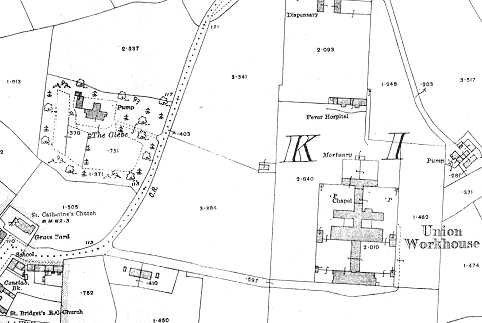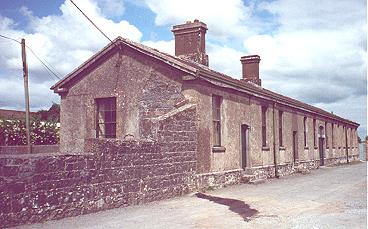Corofin, Co. Clare
Corofin (or Corrofin) Poor Law Union was one of the second wave of Irish unions created between 1848 and 1850. The new union was formally declared on 22nd February 1850 and occupied an area of 96 square miles that had formerly been part of the Ennistymon Union. In 1905, it comprised the following electoral divisions:
Co. Clare: Ballyreighter, Boston, Corofin, Glenroe, Killinaboy, Kiltoraght, Muckanagh, Rath, Ruan.
The new workhouse, for 500 inmates, occupied an 12-acre site to the east of Corofin. It cost £5,700 to construct, plus a further £915 for fixtures and fittings.

Corofin workhouse site, 1915.
The layout of the Corofin workhouse did not adopt the standard earlier design found, for example at nearby Ennistymon, but neither did it adopt the typical second wave layouts, as seen for example at Kildysart. Corofin's design was, however, similar to its neighbour at Ballyvaughan built in the same year.
The workhouse had a long single-storey entrance block at the east which included porter's lodge, reception wards and school rooms. To the rear were the main accommodation and utility blocks linked via a central spine containing the chapel to a small infirmary at the rear. A mortuary and fever hospital lay to the rear of the site. Between 1899 and 1916, a link block was constructed from the centre rear of the entrance building to the main block.
In 1895, Corofin was visited by a "commission" from the British Medical Journal investigating conditions in Irish workhouse infirmaries. Their report suggested a number of improvements: the provision of two trained nurses, one being a midwife; more comforts for the patients such as improved bedsteads and bedding; improved cooking to make the food eatable and appetising; and the provision of running water and improved sanitary facilities throughout the workhouse. Further details are available in the full report.
At the 1901 census, the population of the Union was 4,803 with 4 officials and 74 inmates in the workhouse.
All that now remains of the workhouse is the single-storey front block, used in more recent times as a storage depot.

Corofin Union Workhouse entrance block from the south-west, 2000.
© Peter Higginbotham.

Corofin Union Workhouse entrance block from the south, 2000.
© Peter Higginbotham.
Records
Note: many repositories impose a closure period of up to 100 years for records identifying individuals. Before travelling a long distance, always check that the records you want to consult will be available.
- Clare County Library, The Manse, Harmony Row, Ennis.
Bibliography
- Crossman, V (2006) Politics, Pauperism and Power in Late Nineteenth-century Ireland
- Gray, P (2009) The Making of the Irish Poor Law, 1815-43
- O'Connor, J (1995) The Workhouses of Ireland
Links
- None.
Unless otherwise indicated, this page () is copyright Peter Higginbotham. Contents may not be reproduced without permission.


